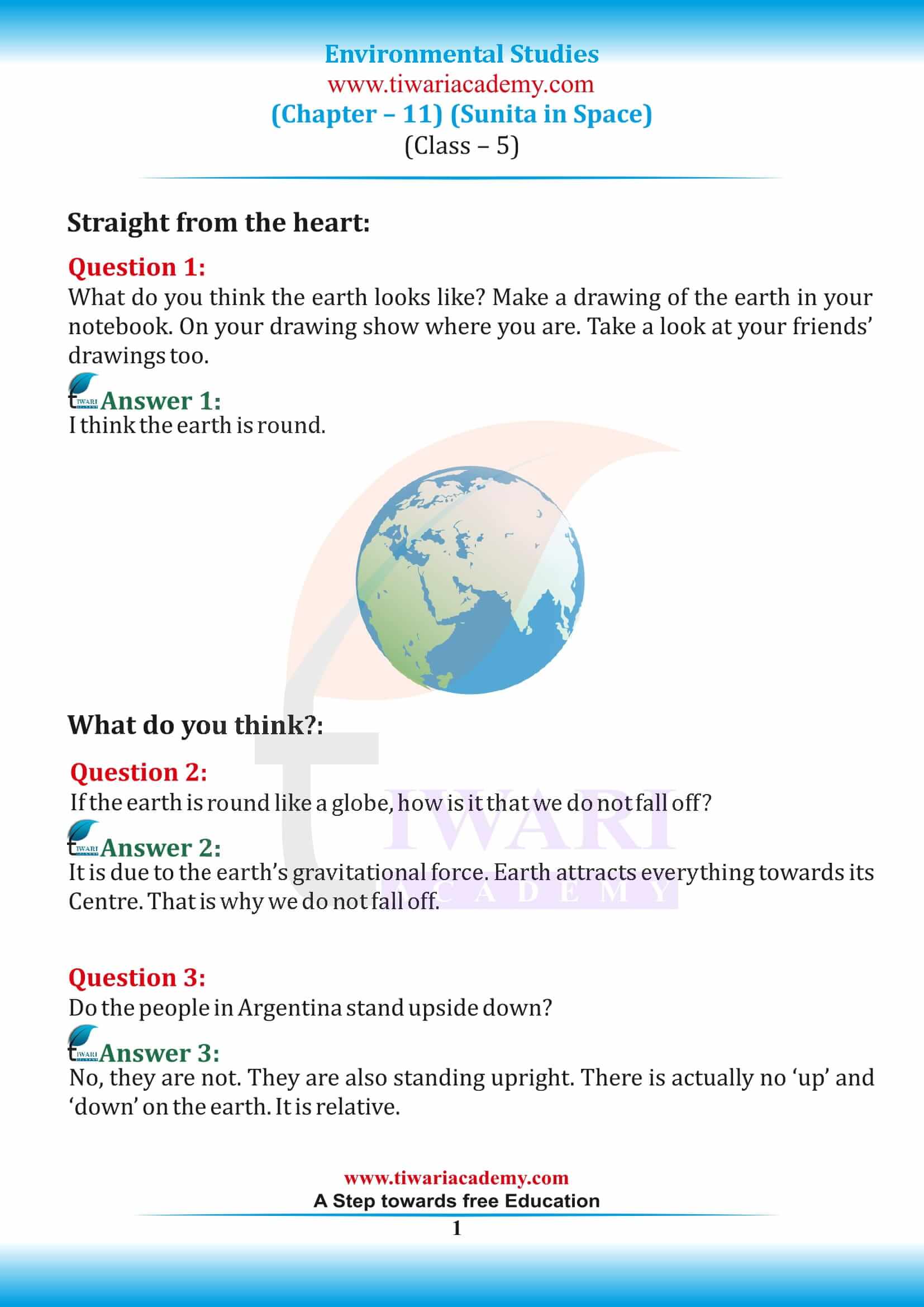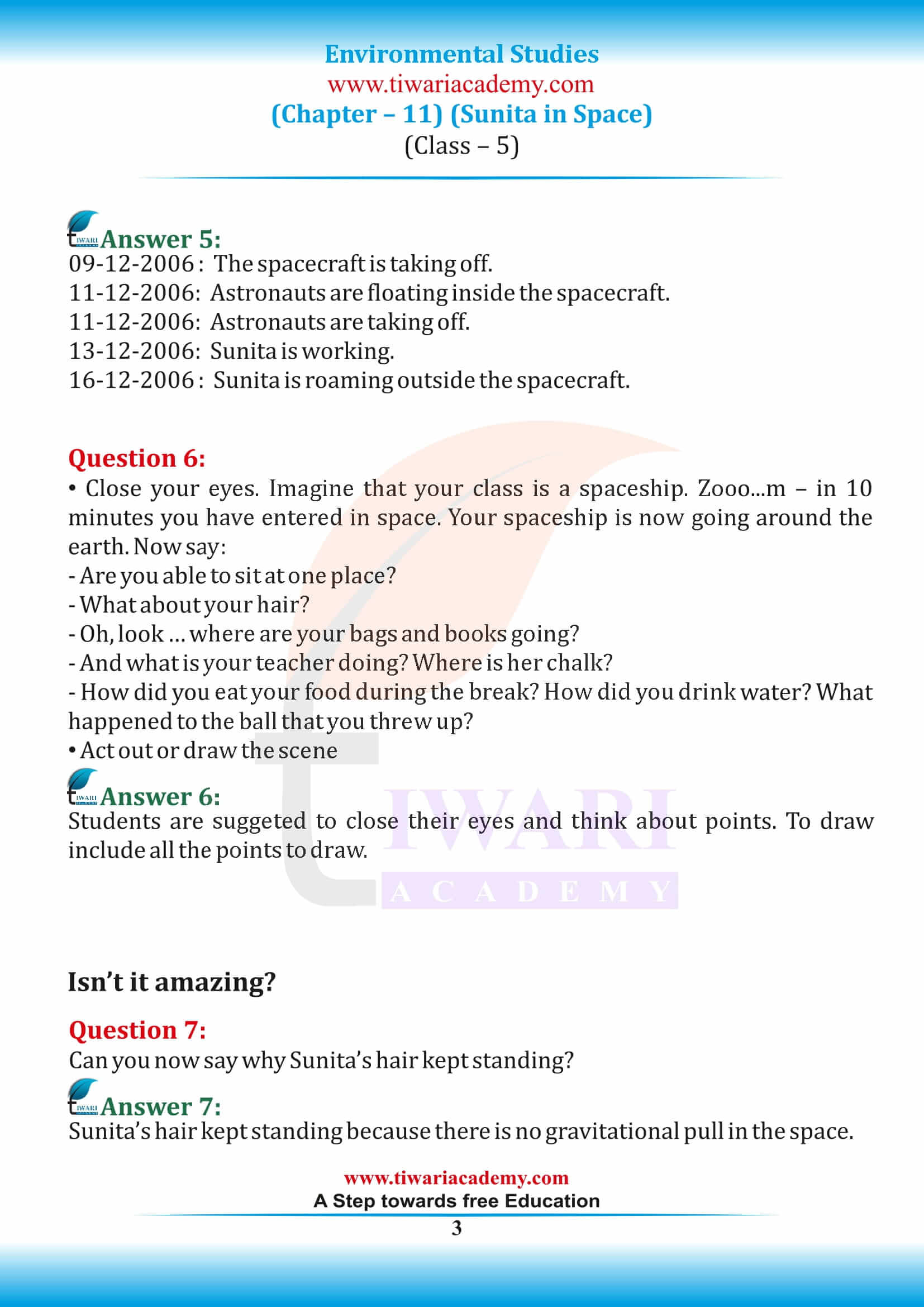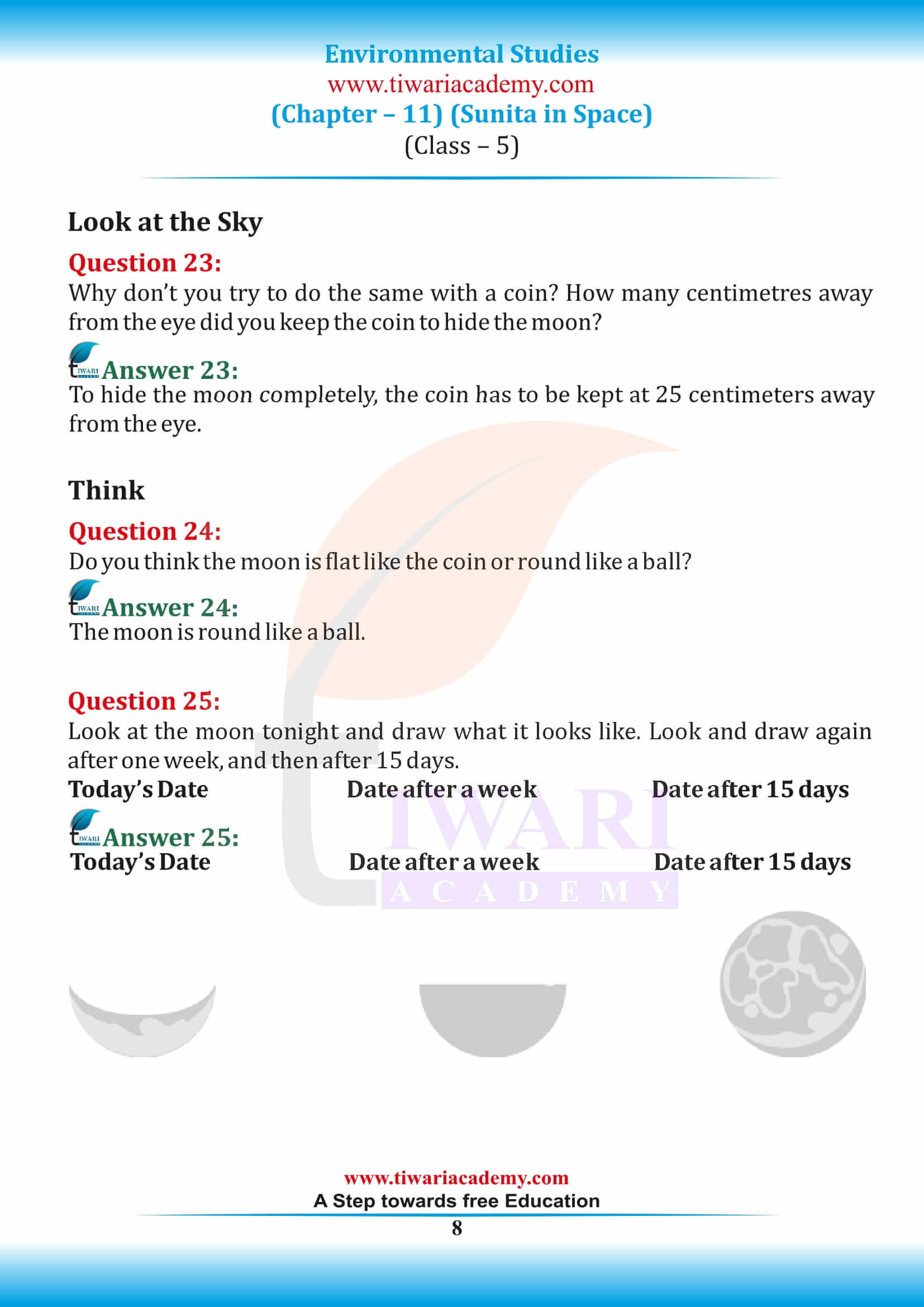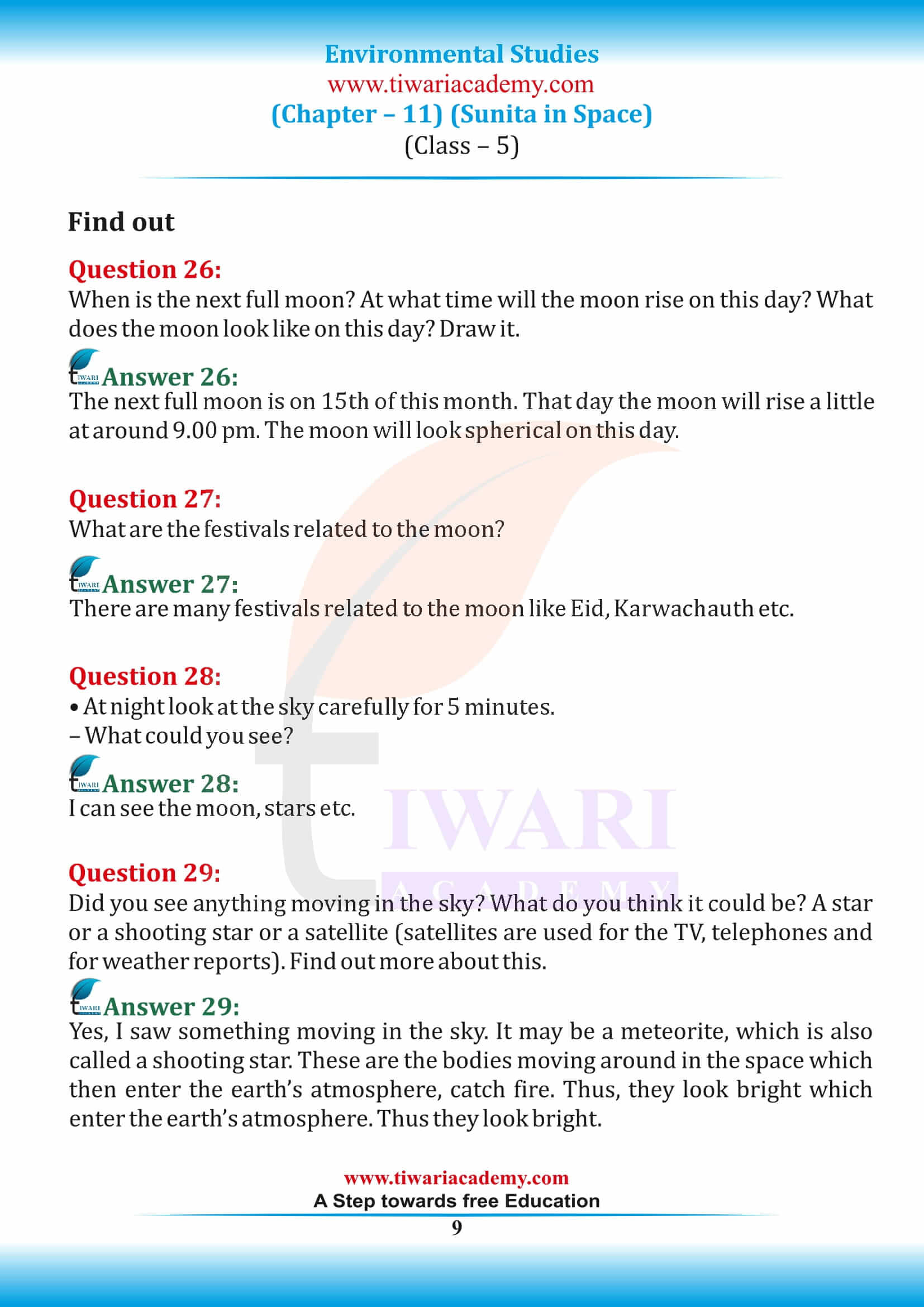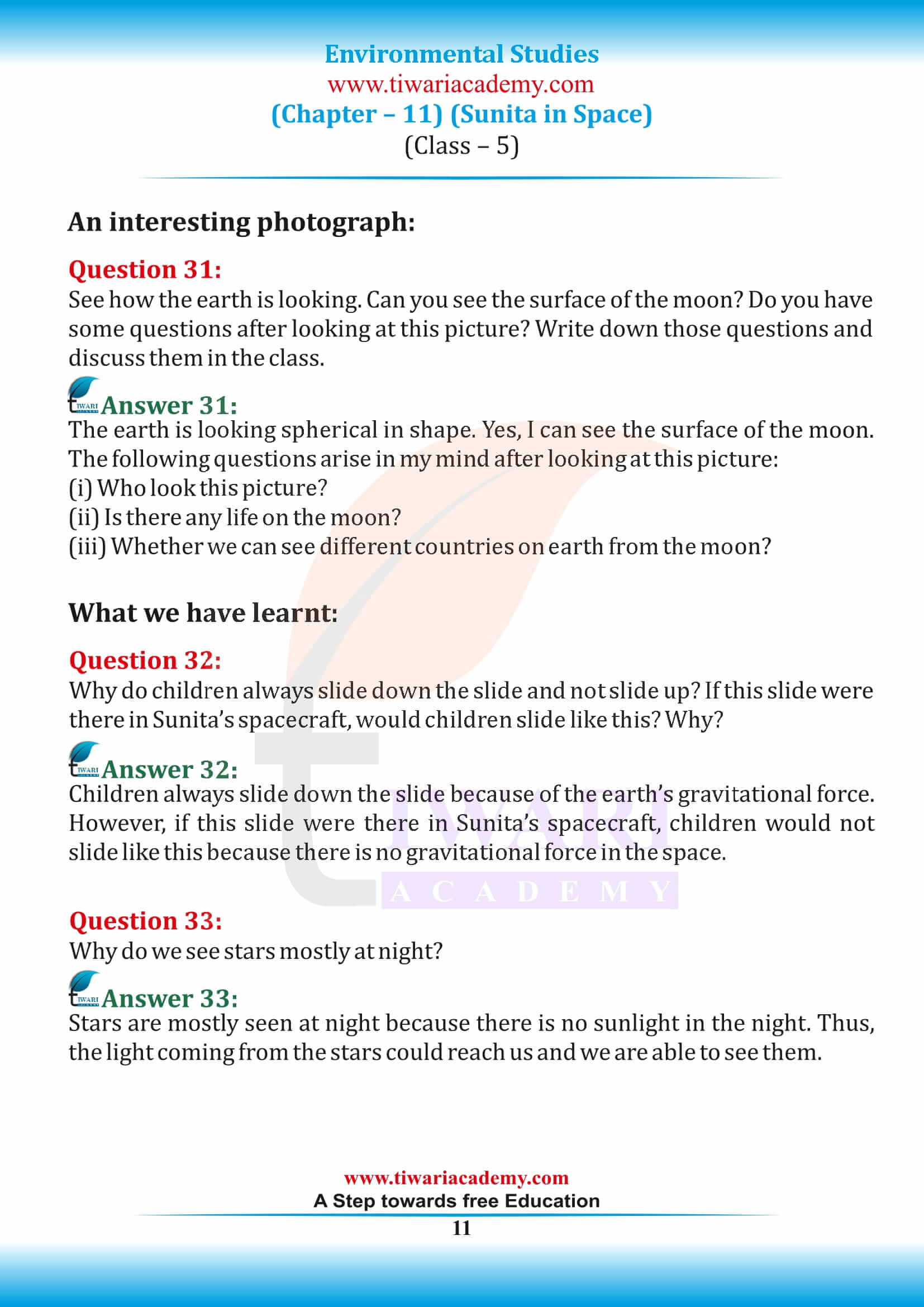NCERT Solutions for Class 5 EVS Chapter 11 Sunita in Space in Hindi and English Medium all question answers with extra questions updated for 2024-25. Get answers related to Chapter 11 of 5th EVS. Solutions for grade 5 Environmental Studies are given here in updated format free to use with any registration. Extra questions based on Class 5 EVS Chapter 11 will help the students during the revision for exams and tests.
NCERT Solutions for Class 5 EVS Chapter 11
Class 5 EVS Chapter 11 Question Answers of Sunita in Space
Class 5 EVS Chapter 11 Question Answers Set 1
Define the following terms: i. Earth ii. Axis iii. Globe iv. Equator
i. Earth-It is a planet that revolves around the sun. It is called the blue planet as three-fourth of it is covered by water and one -fourth by land. It has two Hemispheres-Northern and Southern Hemisphere.
ii. Axis- An axis is an imaginary line that runs through the earth from the North Pole to South Pole on which the earth rotates from west to east.
iii. Globe-It is the model of the earth which is a three- dimensional representation of the earth.
iv. Equator- An equator is an imaginary line around the middle of a planet or other celestial body. It is halfway between the North Pole and the South Pole, at 0 degrees’ latitude and it divides the planet into a Northern Hemisphere and a Southern Hemisphere.
Why we do not fall off the surface of the earth, even though it is round.?
Why we do not fall off the surface of the earth, even though it is round.?
Ans. We do not fall off the surface of the earth even though it is round because of the force of gravity present on the earth. Earth is like a sphere so there is no up and down. It is the force of gravity that works like a magnet which helps to pull everything towards its center. The strength of this pull depends on the mass and the distance between the objects.
Is there any force of gravity on the moon?
Yes, moon has gravity which is one -sixth of the earth’s gravity when compared to the earth. So, any object will weigh one-sixth of its weight on the moon as compared to its weight on the earth.
Is there zero gravity in space? Explain.
No, a very small amount of gravity called Micro-gravity can be found in the space too.
It is the condition in which the people as well as the objects appear to be weightless. Its effects can be seen when the astronauts float in the space.
Question:
Give examples to prove that there is force of gravity present in the space.
Answer:
Examples which prove the presence of gravity in the space are:
- Gravity holds the moon and the man- made satellites in their orbits around the planets.
- Gravity causes the earth and other planets to orbit around the sun.
- Gravity keeps the sun in place in the milky-way galaxy.
Class 5 EVS Chapter 11 Question Answers Set 2
Why does the ball thrown into the air comes down on the earth?
The ball thrown into the air comes down on the earth because the force of gravity or the earth’s gravitational field which is always focused downwards (towards the center of the earth.)
So, when the ball is thrown up, it is going against the earth’s gravitational field and so, the earth’s gravitational force pulls it back down, accelerating it downwards.
Shooting star is not a star?
Shooting stars look like stars that shoot quickly across the sky but they are not stars in actual. They are a small piece of rock or dust that hits the earth’s atmosphere from the space. It moves too fast that it heats up and glows as it moves through the atmosphere. They are called Meteors which burnup mostly before they reach the ground. If it reaches the earth’s surface, it is called a meteoroid.
What is a meteor? Ans.
Meteor is a small body of matter which comes from the outer space and enters the earth’s atmosphere, becoming radiant due to friction and appears as a streak of light.
What is a meteoroid?
A meteoroid is a small rocky or metallic body found in the outer space. Meteoroids are smaller than asteroids, and range in size from small grains to one-meter-wide objects.
Question:
Why do people in Argentina do not fall off the Earth.
Answer:
Argentina is located in the lower part of the Southern Hemisphere still people do not fall off the earth like every other place on the earth because the force of gravity keeps everything away from falling off it. The force is exerted by the earth’s mass which pulls all the objects in the direction of the earth’s center.
Class 5 EVS Chapter 11 Question Answers Set 3
Why can we see stars both during day and night? Ans.
As there is no atmosphere on the moon, it helps to scatter the sunlight there. Since sunlight is a huge spot only, it does not have a bright glare because of which the sky appears dark at all times and thus the stars are visible during day and night.
So, if you were standing on the Moon where there is no atmosphere, you would see the stars both day and night.
Why are we not able see the stars and moon during the daytime?
The reason that we cannot see the stars and moon during the daytime is that the sun’s rays suppress the faint light coming from the stars. During the night, when the sun’s rays get blocked by the other side of the earth, it is possible to see the faint light of the stars shining in space.
What would happen if there is no gravity on the earth.?
The most important thing which holds to the earth because of gravity is atmosphere and water.
Without gravity the air in the atmosphere will not stick around, so it will immediately begin drifting away off into the space.
Water on the earth would also depart. And earth itself would also break into chunks and float off into space since it is held together by gravity only.
What would happen if we try to go up the slope of a slide?
We will have to apply an effort to move up as we are going against the force of gravity, since this force works to pull everything towards the center of the earth.
Question:
Differentiate between a star and a planet.
Answer:
| Star | Planet |
|---|---|
| A star has its own heat and light | A planet does not have its own heat and light. It reflects the light of sun |
| A star is fixed and rotates about its own axis only. | A planet rotates about its axis as well as revolves around the sun. |
| A star is made up of gases. | A planet is made up of rocks and gases. |
Question:
Differentiate between a planet and a satellite
Answer:
| Planet | Satellite |
|---|---|
| A planet revolves around the sun | A satellite revolves around the planet. |
| A planet is a natural object. | A satellite can be natural or manmade. |
Question:
What is mass?
Answer:
Mass is the measurement for the amount of matter in an object. Greater the mass, greater is the gravitational pull.
Class 5 EVS Chapter 11 Question Answers Set 4
Why can’t we see the full earth from the surface of the moon?
When we are on the moon, we can see only half of the earth because we are able to see only that part of the earth which is receiving and reflecting the sunlight. The other part is not visible as it is not receiving the sun light.
How far is the moon from the earth?
The moon is 3,84,400 kms away from the earth.
What is a space craft?
Space craft is a machine or a vehicle that is specifically designed to be used for flying into space. It is also called a space shuttle or space ship.
What is the full form of NASA?
The full form of NASA is National Aeronautics and Space.
Class 5 EVS Chapter 11 Question Answers Set 5
Why do we see a different phase of moon every night?
We see a different phase of moon every night because the moon orbits around the earth and the part of the moon that faces the sun is lit up and the part which is not facing the sun is dark.
So, the phase of the moon depends on its position in relation to the sun and Earth. The phases change because the moon revolves around Earth and different portions of the moon’s sunlit surface are visible from Earth.
Where does the moon disappear on a new moon night?
The moon is there in the sky but on a new moon night, it is directly between the earth and the sun and thus that part, which is facing us doesn’t receive sunlight and we think that the moon has disappeared.
How much time does the moon take to revolve around the earth?
The moon revolves around the earth in an elliptical orbit and takes 29.53 days from one full moon to another.
What do you understand by First Quarter and Last Quarter of the moon?
First Quarter is the half-moon phase that appears after the new moon and before the full moon and Last Quarter is that half-moon phase that appears before the waning crescent when it reaches the new moon phase again.
What is astronomy?
Astronomy is the study of all the things that are in the universe beyond Earth’s atmosphere which includes objects that we can see with our naked eyes, like the Sun, the Moon, the planets, and the stars. It also includes those objects that we can only see with telescopes or other instruments, like faraway galaxies and tiny particles etc.
Question:
What happens when you can’t see the moon?
Answer:
When we can’t see the moon, the new moon phase happens monthly and this is because of our view from Earth, as the moon orbits us. During the new moon phase, no sunlight is reflected by the moon and the side that is all lit up is facing away from earth.
Class 5 EVS Chapter 11 Question Answers Set 6
How does the moon change phases?
Every night, the moon shows us a different face in the night sky. As the moon travels in its 29-day orbit, its position keeps on changing daily. Sometimes it’s between the Earth and the sun and sometimes it’s behind us. So, a different section of the moon’s face is lit up by the sun, causes it to show different phases.
What is Gibbous moon?
Gibbous moon is the name given to the phase of the moon when the shape of the moon is between half and full moon. It is three-fourth of its size.
What does the earth look like from space?
The Earth looks like a blue marble from the space. Some parts are brown, yellow, green and white. Water covers most of Earth.
Who is Sunita Williams? What world record has she made?
Sunita Williams, Indian-American astronaut Sunita Williams returned to earth after 127 days in space with a new record of the most spacewalking time by a female at 50 hours and 40 minutes over seven career excursions.
What are constellations?
A constellation is a group of stars that together form specific patterns. They are easily recognizable in the night sky and there are 88 official constellations. Few examples of a constellation are- Scorpio, Great Bear, Orion.
What are asteroids?
Asteroids are small, rocky objects that orbit the Sun. The asteroids orbit the Sun like the planets but they are much smaller than planets.
Question:
What were Sunita’s experiences of living in space?
Answer:
Sunita’s experience of living in space were as follows:
• They could not sit at one place. We kept floating in the spaceship from one end to another.
• Water too doesn’t stay at one place. It floated around as blobs. To wash their face or hands they had to catch these blobs and wet paper with them.
• They ate very differently there. They all had to float into the dining area of the spaceship and catch the floating food packets
• In space there was no need to use a comb. Her hair kept standing all the time.
• They were not able to walk and had to get used to floating around.
• They had to learn to do simple things differently. To stay at one place, they had to strap themselves there.
• Papers also had to be stuck to the wall of the spaceship.
Class 5 EVS Chapter 11 Question Answers Set 7
Why did Sunita come to India?
Sunita was a good friend of Kalpna Chawla who wanted to come to India and meet children of India. She came to India to fulfil Kalpana’s dream.
Why did Sunita experience the pull of the earth in the space ship?
Sunita did not experience the pull of the earth in the space ship because the spaceship was revolving around the earth.
What is the shape of the earth?
The shape of the earth is oblate spheroid, or oblate ellipsoid. It is an ellipsoid of revolution which is obtained by rotating an ellipse about its shorter axis. This is because the earth is flattened at the poles and bulges out at the Equator.
What is the difference between natural satellite and artificial satellite?
A natural satellite is a satellite which was created by nature, like the moon. The Earth’s moon is one example of a natural satellite.
Whereas an Artificial satellite also called man-made satellite is made by humans, like communications satellites. An artificial satellite is built on Earth and then taken into orbit by rockets or released by a space station
Question:
Describe the different phases of moon
Answer:
We see a slightly different view of the Moon each night. There are basically eight phases or shapes of Moon visible to us which are:
- New moon
- Waxing Crescent
- First Quarter
- Waxing Gibbous
- Full moon
- Waning Gibbous
- Third Quarter
- Waning Crescent
i. New moon occurs when the Moon is between Earth and the Sun, and thus the side of the Moon that is in shadow faces the earth.
ii. Waxing Crescent Moon phase starts after New Moon and lasts until half of the Waxing Moon’s surface is lit at First Quarter Moon.
iii. First Quarter is a primary Moon phase when half of the Moon’s face is lit up. Whether it is the left or right half depends on where you are on Earth.
iv. Waxing Gibbous occurs when more than half of the lit portion of the Moon can be seen and the shape waxes which means increases in size from one day to the next. The waxing gibbous phase occurs between the first quarter and full moon phases.
v. Full moon occurs when the Moon is on the opposite side of Earth from the Sun, and thus the side of the Moon that is illuminated faces Earth. A full moon is when we can see the entire lit portion of the Moon.
vi. Waning Gibbous moon occurs when more than half of the lit portion of the Moon can be seen and the shape wanes or decreases in size from one day to the next. The waning gibbous phase occurs between the full moon and third quarter phases.
vii. Third Quarter rises in the middle of the night and sets in the middle of the day. This is the opposite of a First Quarter Moon, which rises around midday and sets around midnight.
viii. Waning Crescent is the last phase of the moon. During this phase, the lit part of the moon gets smaller and smaller, until the cycle meets its end, starting again with the new moon.
Class 5 EVS Chapter 11 Question Answers Set 8
What is an eclipse? Name and define the two types of eclipse.
An eclipse occurs when an object comes in between you and another object and blocks your view. From Earth, we normally experience two kinds of eclipses: an eclipse of the Moon called the Lunar eclipse and an eclipse of the Sun called the Solar eclipse.
• A lunar eclipse is caused when the earth comes exactly between the moon and the sun and the Sun’s rays cannot hit the moon. A lunar eclipse can be seen from anywhere on the dark side of the Earth.
• A solar eclipse is caused when the moon exactly blocks the Sun’s rays from hitting the Earth. A solar eclipse can only be seen from certain places on Earth as the moon only blocks the sun for a small area. Solar Eclipses always happen during the new moon phase.
Question:
Whose light does the moon reflect?
Answer:
The Moon does not have any light of its own. There is only one source of light in our solar system, and that is the Sun. Without the Sun, Moon would be completely dark. So, the “moonlight” is just the sunlight which is reflecting off of the Moon’s surface.
What does class 5 EVS chapter 11 answer to?
The chapter is about space and it answers any question that comes to the mind of children because children grew up reading rhymes and poems about the moons and stars. This chapter tried to some of the main questions that they have.
Do you think the chapter will encourage children to learn more about space exploration as per chapter 11 from class 5 EVS?
The chapter is not sharing much of the space-related question just yet but the chapter is indeed encouraging the children to find more questions so that they’d be curious to know about the things and in search for answers they will try to use their minds and study about the Astro science or just science. This chapter shared the story of a lady astronomer who met the children once she was back in India she met children and tried to answer their questions.
What is the most interesting part of the story from chapter 11th about Sunita the astronaut in EVS book of class 5?
The most interesting part of the story I would say is the time when Sunita shared the story when she was in space with that the picture in which she was standing in the air without falling down. Now a day we can see many of such images that can tell us how space and our Earth actually look like but before all that images were published people didn’t have all that answer. Imagining that time this part is something I liked in chapter 11 of EVS class 5.
